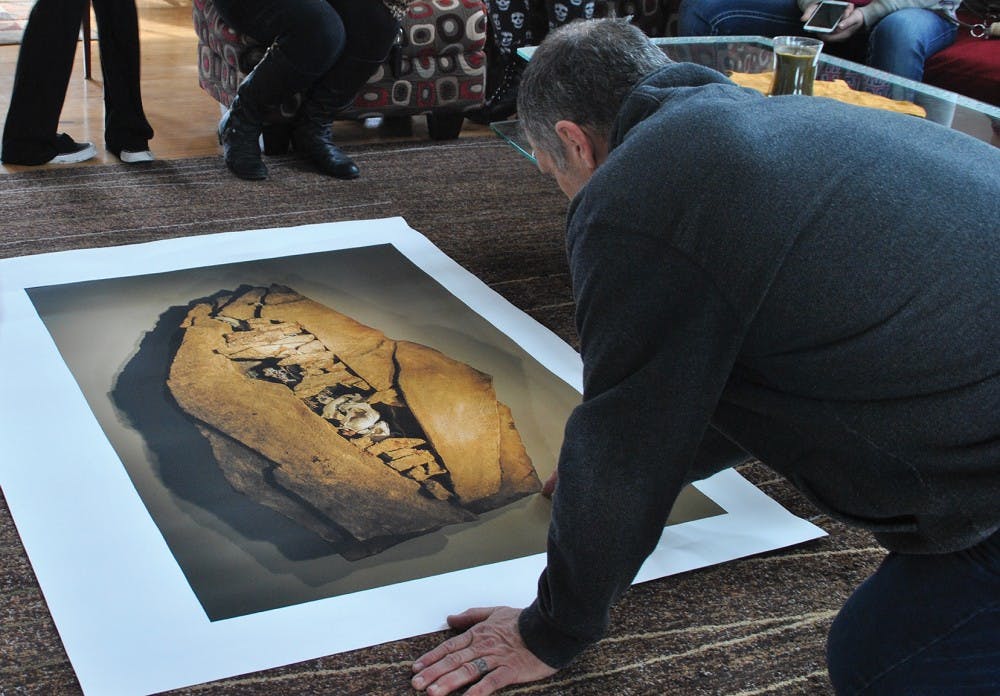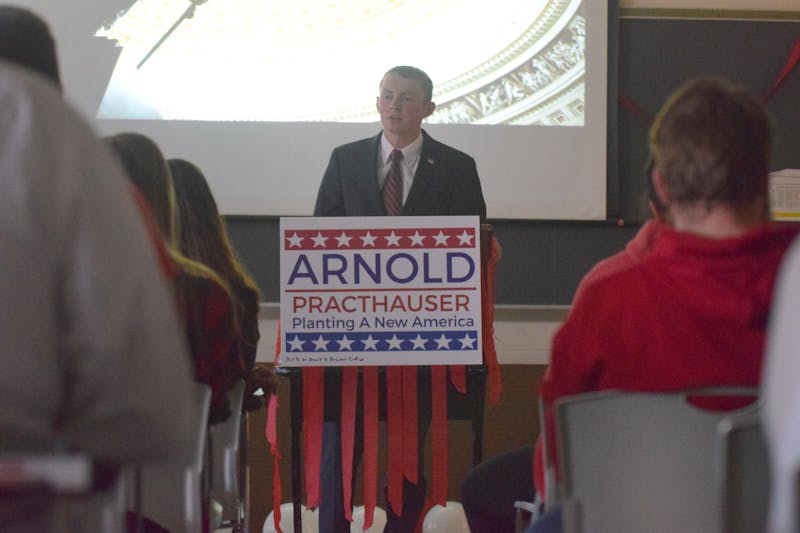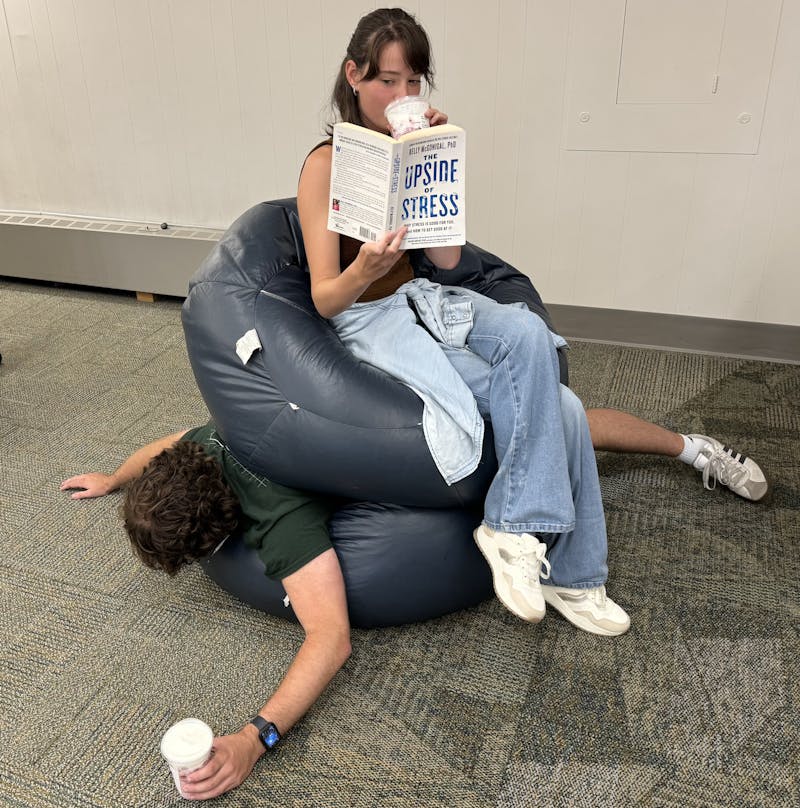A river of metal slips through the backyard, a smooth reflection of the gray November sky. The stainless steel sculpture, 37 feet long, 6 feet wide and 12 feet tall, is an interpretation of the Susquehanna River — a project 10 years in the making with two more to go before its completion.
Its creator, Steve Dolbin, a sculptor and one of Shippensburg University’s art professors, began creating “River Spirit” on a commission, but when the commissioner became ill, the funds disappeared and Dolbin put the project to the side for three years.
Harley Weigle, a junior and one of Dolbin’s sculpture students, said that he thinks it is “commendable” that Dolbin is so determined to finish the project after 10 years.
“It’s not in his character to leave something unfinished,” Weigle said.
The final sculpture will be vertical so that the river rises toward the sky, but its ultimate destination is yet to be decided, so for right now “River Spirit” lives in Dolbin’s backyard behind a barn that he converted into a an art studio. Scattered throughout Dolbin’s lawn is a museum of sculptures that he has created — or as Dolbin said, a series of obstacles when it comes time to mow the lawn.
Inside Dolbin’s studio lives even more of a testimony to his work as an artist — two of the sculptures will be traveling to London, where Dolbin will presenting his exhibit at the Royal College of Art from Dec. 10–15. One of the sculptures, “Guardian Niche,” is too large to ship, so he will be presenting a high-definition digital photograph of the sculpture. The other, “Pestle,” will be presented in its actual form.
Dolbin has worked hard to get where he is, said one of Dolbin’s colleagues, Kate Keely, SU professor and working artist. Some people attribute success to luck, but Keely said that people who work hard make their own luck — which is what Dolbin has done.
“It’s a whole other level when you start to get recognized internationally. They are seeing his work is relevant and for an artist that’s a very important thing,” Keely said.
Keely said that Dolbin’s work, which relates to the environment, the human condition and how people impact the environment, are concepts that transcend to the core of humanity, not just one specific group of people. The universal archetypes, or timeless symbols, make it easy for people coming from different cultures all over the world to look at his work and understand it.
Dolbin’s personality fills a room with his booming voice and waving hands just has his artwork fills a room with its massive size and power — the kind of power that starts as a tickling whisper and spreads to a dense, thick silence that is louder than any noise.
“I’m such a noisy, energetic, outspoken person, but my work is just so quiet,” Dolbin said, forehead creased, face serious. “It’s like a clock ticking when nobody’s home. It’s just so quiet. But that’s what’s so powerful about it. It’s just overwhelmingly potent because of the quiet quality.”
Although the meaning behind his work is accessible to everyone, the message is not always obvious, Keely said.
“He doesn’t hit the viewer over the head, which is great. He’s asking the viewer to work a little bit. The viewer needs to think a little bit and make some connections,” Keely said.
When his art is showcased, Dolbin said people look at it and become enraptured by its meditative quality, which is exactly what he wants his art to do.
“Artists can’t say a whole lot, but we need to make you feel like you can access your own mind in whatever situation you’re in instead of trying to lecture people,” Dolbin said. “I try to expose them to things and see what happens, because I don’t want to alienate the people I’m trying to change.”
It is through his students and his family that Keely said Dolbin is also trying to make a difference. By having a positive influence on his students and his children, he will be leaving the world a slightly better place than when he entered, Keely said.
“I think he’s a very sensitive, caring person. He cares about being an artist and a teacher and he often puts students first,” Keely said. “He puts students and his family first and that’s important. And that’s reflective in his artwork.”
Dolbin’s two children, Collin, 17, and Reece, 20, are plastered around Dolbin’s office in photographs. When talking about Reece’s academics or Collin’s artwork, Dolbin’s arm motions become even wilder and his mustache twitches excitedly with his smile. Dolbin’s children, as well as his wife, Robin, are frequently brought into his classrooms in the form of animated stories that he tells to his students.
Robin said Dolbin is a unique combination of strength and sensitivity as a father. He notices things about the environment and people’s emotions — this in turn translates to his art and relationships, Robin said.
“I guess I would like to compare him to his sculpture,” Robin said. “I feel like he’s a rock or pillar for the family. He definitely provides us with strength.”
It is important that Dolbin provides his children with the security to take risks and explore their passion because success is not always monetary — it comes from happiness. He has faced his own struggles in taking the risk to follow his dreams as an artist, Robin said, but he pursued his talents and has become successful as an artist.
Dolbin teaches his students to follow their passion as artists too, he said.
“Once you have the passion you have to go about it the right way,” Dolbin said. “It’s not just going to fall in your lap. You have to work.”
In the classroom, Weigle said that Dolbin is an “awesome” teacher because of the passion he brings. How does Dolbin express this passion? — “Very loudly,” Weigle said.
“He really pushes his students to excel,” Weigle said.
When he was in college, Dolbin said he wanted to be a famous sculptor — not a teacher. But once he began student teaching, it became a desire similar to his fervor to create artwork.
Today, Dolbin’s passions as artist, teacher and father culminate in massive sculptures that represent all of these qualities.




The Slate welcomes thoughtful discussion on all of our stories, but please keep comments civil and on-topic. Read our full guidelines here.